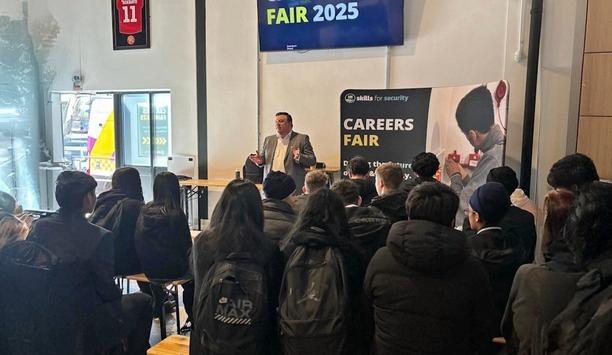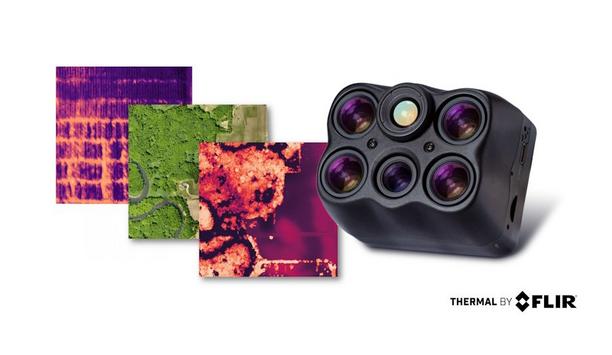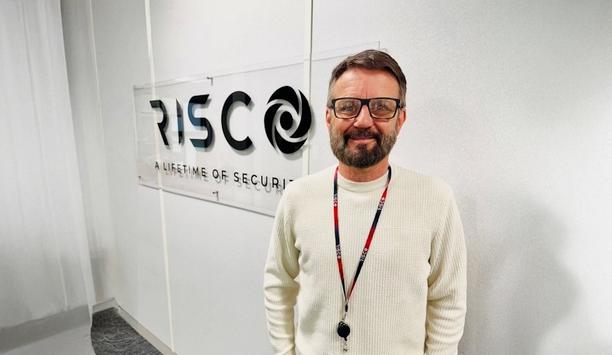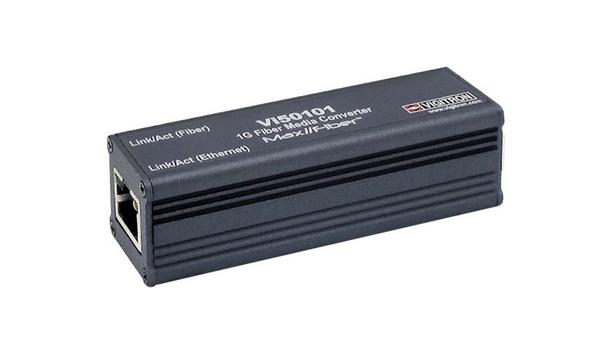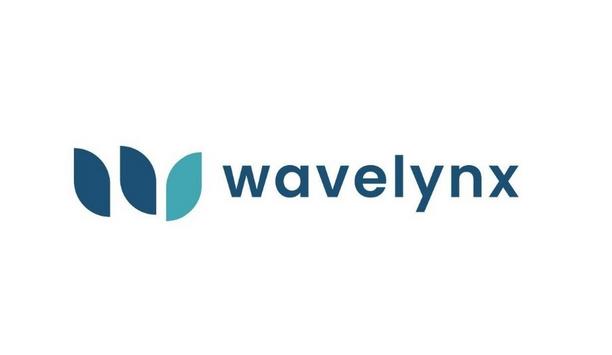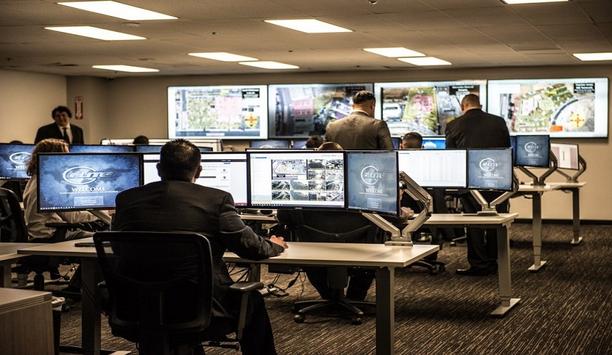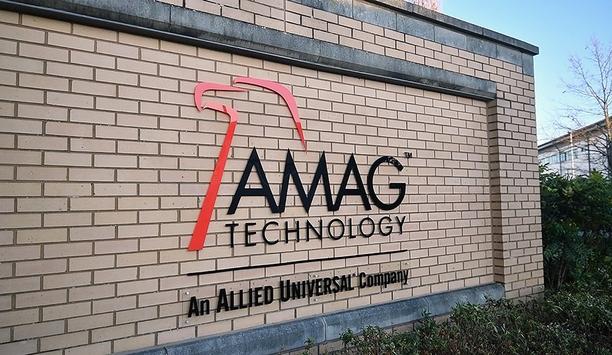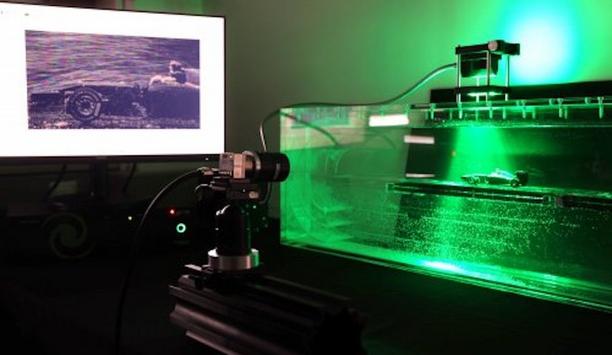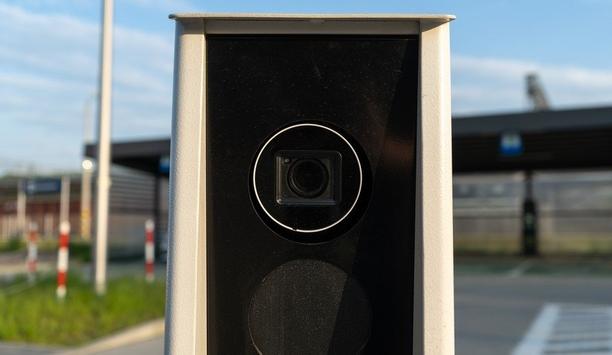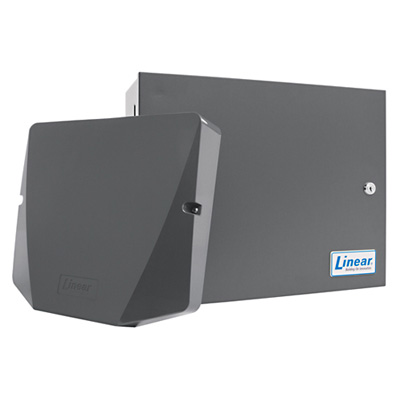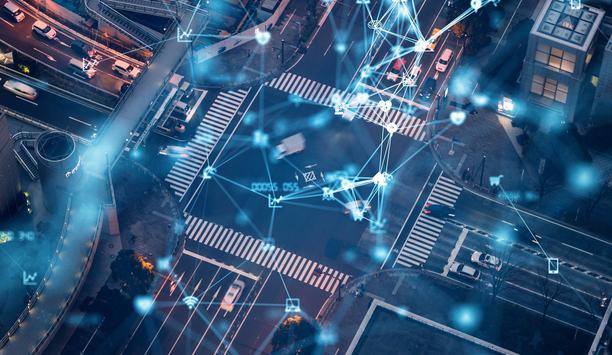Industrial security systems
Magenta Security Services, one of the UK’s pioneer security firms, has achieved an exceptional score of 87.5% in its most recent SIA Approved Contractor Scheme (ACS) audit - placing the company firmly within the top 5% of security companies nationwide. With only the top 10% of security firms scoring above 75%, Magenta’s remarkable result reflects the company’s consistent dedication to quality, compliance, and operational excellence across every area of its business. Exceeding...
Omny looks forward to welcoming Kenneth Titlestad as its new Chief Commercial Officer, effective 1 April 2025. Transitioning from his role at Sopra Steria, where he was instrumental in building the company’s Operational Technology (OT) cybersecurity competence, Kenneth will now spearhead Omny’s commercial strategy, reporting to the CEO and part of the Omny management team. Prior roles of Kenneth Kenneth’s career in OT cybersecurity took root in Equinor, where he leveraged h...
Trackforce, a pioneer in security workforce management software, and Immix, a provider of commercial central station and remote SOC software for managed video and security services, announced a strategic partnership to enhance remote guarding operations through advanced automation and seamless security event management. The collaboration integrates Trackforce’s comprehensive front-line to back-office suite, TrackTik, with the Immix platform to create an industry-first automation...
Fire and Security Apprenticeship Specialist, Skills for Security proudly marks the success of an inaugural Careers Fair, taking place near its Walsall training branch at The Bescot Stadium Locker Room. The event, designed to introduce local school leavers to career opportunities in the fire and security industry, welcomed an enthusiastic turnout of students, educators, and industry professionals. Fire and security sector The event provided a unique platform for students aged 14 to 18 to explo...
Teledyne FLIR OEM, part of Teledyne Technologies Incorporated, announced that Sentera Sensors and Drones, a pioneering provider of advanced sensors and data, has joined the Thermal by FLIR program. Integrating FLIR Boson® thermal camera modules into the Sentera 6X Thermal Series adds new high-precision thermal mapping capabilities to their integrated multispectral and RGB drone payload platform. Sentera 6X Thermal Series Sentera 6X Thermal Series supports agriculture, outdoor, and in...
ABUS, a pioneer in security and safety solutions, has announced the appointment of Adam Evans as the new Managing Director for ABUS UK & Ireland. Adam brings with him a wealth of experience, having built a successful career over the past 20 years in sales and commercial leadership roles, most recently with Ideal Standard. His extensive knowledge of the industry, combined with a strong track record of business growth, makes him the ideal candidate to drive ABUS forward in the UK and Irish ma...
News
RISCO, a pioneer in advanced security solutions, is proud to announce the appointment of Dave Tate as its new UK & Ireland Commercial Director, effective immediately. This key leadership appointment marks the beginning of an exciting new chapter, driven by growth and innovation, as the company strengthens its position in the security industry. Dave’s appointment Dave’s appointment stresses RISCO’s unwavering belief to advancing innovative security Drawing on his extensive knowledge and experience, Dave will oversee the sales, marketing, and technical teams. In addition to driving strategy, he is focused on implementing more efficient processes to enhance overall performance. Dave’s appointment underscores RISCO’s unwavering dedication to advancing innovative security technologies and strengthening its reputation as a trusted partner for industry professionals. Under the new leadership, RISCO UK is poised to build on its rich legacy of innovation and excellence. RISCO's ongoing success and growth "I am delighted to join RISCO during such a dynamic and transformative time," said Dave Tate. "Reflecting on the innovations achieved over the past year, our award-winning training, unique rewards programme and the exciting developments ahead, I am confident that installers across the UK and Ireland will be impressed by our remarkable progress. I look forward to contributing to the company’s ongoing success and driving its growth in the UK market." RISCO UK operation Joint-CEO Maor Alkelai expressed his enthusiasm, stating, “I am delighted to welcome Dave to our team." "His remarkable expertise in our industry is truly impressive, and I am confident that under his leadership, the RISCO UK operation will continue to thrive and reach new heights.”
Absolute Security, the pioneer in enterprise resilience, announced Harold Rivas as its new Chief Information Security Officer (CISO). With more than two decades of experience and proven leadership in the cybersecurity industry. Rivas will oversee global cybersecurity and information technology for the company, including security for products and services, threat management, cyber risk and compliance, and security operations. Harold’s deep expertise “I am thrilled to welcome Harold to the Absolute Security team,” said Christy Wyatt, CEO, Absolute Security. “As we continue scaling and adding to our platform to serve a wide range of industries, Harold’s deep expertise and history of success with top global security providers makes him an excellent addition.” Prior roles of Rivas Prior to Absolute, Rivas served as CISO at Trellix, loanDepot, Santander Consumer USA Prior to Absolute, Rivas served as CISO at Trellix, loanDepot, Santander Consumer USA, and Mr. Cooper. Over the course of his career, he has demonstrated exceptional leadership and expertise in security and risk management. His achievements include helping to fuel growth, developing and implementing effective security strategies and solutions, navigating complex government regulations, and contributing to the development of cybersecurity legislation. Rivas holds an MBA and a Bachelor of Science in Business Management from Western Governors University. Evolving security and complexity challenges "I’m honoured to join Absolute Security. This is a time of tremendous opportunity for the company, as our unique approach delivers the security and resilience enterprises need to thrive in the modern business environment," said Rivas. "CISOs today require solutions that defend against threats, reduce risk, and ensure resilience against disruptions caused by evolving security and complexity challenges. I’m excited to help meet this growing demand."
Cyberattacks are surging globally, with organisations now facing an average of 1,673 attacks per week – a staggering 44% increase from 2023. As AI-powered threats intensify and critical infrastructure such as energy systems become prime targets, CYBSEC-EXPO returns to Piacenza Expo in Italy with a renewed focus on education, collaboration, and cross-industry solutions. A stronger educational focus for 2025 CYBSEC-EXPO will feature an expanded conference programme between 21st–23rd May 2025 Building on its successful debut in 2024, CYBSEC-EXPO will feature an expanded conference programme between 21st–23rd May 2025, delivering critical insights from pioneering global and Italian cybersecurity experts. While the full agenda is yet to be announced, key themes are expected to include AI-driven cyber threats and defence strategies, cybersecurity in energy and critical infrastructure, cloud security and zero-trust frameworks, ransomware resilience and incident response, IoT and OT security for industrial and manufacturing sectors, as well as data privacy and regulatory compliance. Showcasing cutting-edge cybersecurity solutions Alongside the conference, the exhibition will bring together a diverse range of cybersecurity providers, including certification bodies, specialised training organisations, backup and recovery specialists, cybersecurity software developers, data centre service providers, network infrastructure suppliers, and cloud security companies. A critical focus on energy sector security Green hydrogen and nuclear power are gaining speed as vital contributors to the energy supply While last year’s event was co-located with Pipeline & Gas Expo, CYBSEC-EXPO 2025 will run alongside the fourth edition of HydrogEn Expo and the inaugural Nuclear Power Expo. As Europe intensifies efforts to achieve net zero by 2050, green hydrogen and nuclear power are gaining momentum as important contributors to the energy supply. However, a single vulnerability in the operational technology (OT) cybersecurity defences of these industries, could have devastating consequences internationally. Furthermore, the energy sector is one of the top targets for cyberattacks – alongside education, government, healthcare, and telecommunications – experiencing a 42% increase in 2024, making cybersecurity in the hydrogen and nuclear power industries a top priority. Cybersecurity in logistics, manufacturing, healthcare, and more Energy cybersecurity will not be the sole focus of the event, however. CYBSEC-EXPO 2025 will also explore cybersecurity challenges across multiple sectors, including shipping, logistics, automotive, aviation, manufacturing, defence, healthcare, and more. The conference and exhibition aim to equip businesses across industries with the knowledge and tools needed to safeguard their operations, protect sensitive data, and mitigate financial and reputational risks. A memorable networking experience CYBSEC-EXPO 2025 will foster meaningful connections via a dedicated networking event Away from the main venue, CYBSEC-EXPO 2025 will foster meaningful connections through a dedicated networking event and gala dinner on Thursday 22nd May, open to participants of both CYBSEC-EXPO and Nuclear Power Expo. This convivial setting will provide further opportunities for industry professionals to make new contacts and exchange ideas, strengthening cross-industry collaboration. Cybersecurity threats “As cybersecurity threats continue to evolve, CYBSEC-EXPO 2025 will serve as a vital hub for businesses to stay ahead of emerging risks and explore cutting-edge solutions,” said Fabio Potestà, director of the organiser Mediapoint & Exhibitions. “By bringing this event alongside HydrogEn Expo and the first-ever Nuclear Power Expo, we are creating an unprecedented opportunity for professionals from critical industries to collaborate, share expertise, and drive innovation in digital security. Cyber threats are not confined to any one sector – they impact us all, and CYBSEC-EXPO is the place to find the strategies and solutions needed to stay protected.”
Vigitron, a pioneer in networking solutions for security applications, introduces the Vi50101 Mini Fibre Media Converter, a powerful yet ultra-compact solution designed to expand fibre connectivity with ease. With increasing bandwidth demands from high-megapixel and multi-sensory cameras, fibre usage is rapidly growing, particularly for long-distance transmissions. However, many network switches have limited fibre ports, creating expansion challenges. Vi50101 plug-and-play solution Powered by PoE, the ViSO101 eliminates the need for external power adapters, simplifying installation The Vi50101 addresses this by converting fibre to UTP, allowing seamless fibre port expansion without the need to replace existing equipment. The Vi50101 is a true plug-and-play solution for expanding fibre networks without additional power requirements. Supporting up to 1G Ethernet speeds and transmission distances of up to 80 km, it is ideal for security and industrial applications. Powered by PoE, the ViSO101 eliminates the need for external power adapters, simplifying installation. Its compact design allows for flexible placement, whether in-line, wall-mounted, or on a DIN rail, making it a versatile choice for a wide range of network environments. Key features SFP Standard - Compliant with standard Small Format Pluggable (SFP) fibre converters. PoE-Powered - No external power needed, works directly with PoE from switches. Long-Distance Transmission - Extends fibre connectivity up to 80 km. High-Speed Performance - Auto-select 10/100/1000Base-T Ethernet. Compact & Durable - Built to withstand harsh environments (−10°C to +70°C). Versatile Mounting Options - Supports in-line, wall-mount, or DIN rail installation.
Wavelynx has announced a strategic partnership with Smart Spaces, a smart building operating system provider. As part of this strategic relationship, Smart Spaces is integrating Wavelynx’s mobile wallet credentials into the Smart Spaces OS platform and app. This will provide users with a seamless approach to managing building access and enhancing operational efficiency, security, and overall user experience. Driving the future of secured buildings The partnership delivers a solution designed to streamline operations for landlords and corporations "Interoperability is the future of access control, and our partnership with Smart Spaces ensures building security leaders stay ahead," said Rob Lydic, president of Wavelynx. "Together, we’re delivering a seamless, secure, and flexible platform that meets today’s needs while adapting to the innovations of tomorrow." Smart Spaces enables comprehensive control over building systems such as lighting, energy, maintenance, meeting rooms, and climate management. By combining Smart Spaces’ IoT capabilities with Wavelynx’s advanced access control solutions, the partnership delivers a solution designed to streamline operations for landlords and corporations. Key benefits of the partnership The partnership will offer enterprise businesses a range of benefits, including: Enhanced Security: Integration of access control with building management systems for stronger overall security. Improved Efficiency: Automation and streamlined workflows optimise operational management. User-Friendly Experience: A touchless, mobile wallet-enabled solution for convenient building access. Sustainability: Advanced technologies reduce energy consumption and waste, supporting environmental goals. Future of smart and secure building management "In today’s rapidly evolving landscape, organisations need access control solutions that seamlessly integrate security, efficiency, and sustainability," noted Dan Drogman, founder and CEO of Smart Spaces. "Our partnership with Wavelynx enables businesses to leverage advanced technology for a streamlined, secure experience - setting a new standard for modern building management." This announcement builds on Wavelynx’s recent expansion into the UK and Ireland, addressing the rising demand for scalable access control solutions that enhance both security and operational efficiency. As Wavelynx continues to expand globally, it is empowering businesses to modernise on their own terms, setting a new standard for innovation and flexibility in security technology.
Secure Logiq is pleased to announce the appointment of Hossam Abouzeid as Business Development Manager for the Kingdom of Saudi Arabia and Bahrain. By appointing Hossam Abouzeid, a dedicated and experienced professional, Secure Logiq is not only reinforcing its presence in the Middle East but also supporting clients with expert guidance. Key role in Secure Logiq Abouzeid brings over seven years of experience in the security and surveillance industry, having previously worked with pioneering security systems distributor ZMR in Saudi Arabia. His deep understanding of the market, coupled with strong industry relationships, positions him to play a key role in Secure Logiq’s continued growth in the region. Secure Logiq product portfolio Secure Logiq entered the Middle East market in 2022 and has since experienced significant growth “I am honoured to be part of a team that is pioneering innovation in this space,” said Abouzeid. “In this new role, I am excited to leverage my experience and connections to bring Secure Logiq’s high-performance, reliable and cost-effective solutions to the region." "I am looking forward to driving success, fostering partnerships and contributing to safer, smarter communities! Projects here are immense and I am certain that the Secure Logiq product portfolio is perfectly positioned to offer the very best engine to any hyper scale electronic security solution.” Brand awareness and public trust Secure Logiq entered the Middle East market in 2022 and has since experienced significant growth. Speaking at Intersec, Middle East Regional Director Anand Subbiah highlighted the company’s achievements: “In 2024, we had a very good year, not just in terms of sales, but also in brand awareness and public trust." "We’re looking forward to 2025 as a strong growth year to further establish Secure Logiq across the region.” Secure Logiq’s continued growth With a growing footprint in Saudi Arabia, Qatar, Kuwait and beyond, Secure Logiq continues to establish itself as the pioneering provider of high-performance security hardware. "We are thrilled to welcome Hossam to the team,” said Ben Yoxall, Commercial Director of Secure Logiq. “We look forward to the positive impact he will bring to Secure Logiq’s continued growth and the overall security landscape in the Middle East."


Expert commentary
Amidst the challenges of a prevailing economic downturn, the retail sector finds itself grappling with an unparalleled rise in incidents of shoplifting, theft, and burglaries. The disconcerting scenes witnessed on London’s Oxford Street in August 2023, where crowds gathered, looting as many stores as possible, sent shockwaves across the nation’s retailers. This alarming surge in retail crime has put retailers on high alert, as they contend with a rising tide of security concerns. Shoplifting concerns Recent data from the Union of Shop Distributive and Allied Workers (USDAW), has raised alarming concerns: shoplifting rates have surged by an unprecedented 24%. In the first half of 2023 alone, there were approximately 8 million reported shoplifting incidents. With the ongoing burden of the cost of living crisis and the approaching festive season, it is expected that these figures will keep surging. Implementing robust security measures Theft and prevention strategies cost retailers approximately £2 billion in 2021/2022 While more help from the Government to support retail workers and the businesses shoplifters target is certainly needed, the implementation of robust security measures will significantly contribute to deterring these crimes from occurring in the first place. British retailers spend millions on tools to deter and catch shoplifters inside stores, from CCTV and security guards to electronic tagging and alarms. The Grocer reported that theft and prevention strategies cost retailers approximately £2 billion in 2021/2022. Despite these initial costs, other threats are at play beyond the shop floor. Break-ins by criminal gangs For many large town centre stores and supermarkets, and units in retail parks, the rear doors and delivery areas are commonly targeted by criminal gangs. It’s not uncommon for thefts to occur from pallets or cages that have been unloaded from lorries and sit waiting to be moved into the building. After-hours break-ins are a risk for all store owners too, particularly over the festive season when a lot of high-value stock has been delivered to shops and supermarkets. Addressing anti-social behaviour The additional fencing was deemed an essential measure to safeguard the community Anti-social behaviour also poses a challenge for retailers. In 2022, an Aldi based in Derby invested in security fencing to protect staff and deter loitering groups. The additional fencing was deemed an essential measure to safeguard the community, as dangerous items were frequently found outside the store, including weapons and hypodermic needles. So how do physical security solutions such as fencing and gates help better protect retail establishments such as supermarkets and edge-of-town retail park shops? Fencing and gates: a critical component of retail security 1. Risk assessment and target hardening A thorough risk assessment will identify potential weak spots that require protection. ‘Target hardening’ involves implementing physical security measures that become more robust as they approach the target. This helps deter intruders while ensuring ease of access for customers and staff. 2. Effective perimeter security Opt for difficult-to-climb security fencing that provides a robust obstacle against thieves, vandals, and intruders Selecting fencing solutions according to the potential threats, site characteristics, and topography is crucial. It is important to specify fencing that strikes a balance and maintains a welcoming appearance while safeguarding external areas of the store or warehouse from potential harm and unauthorised access. Solid fencing which provides concealment can help to conceal expensive goods and remove them as a target for opportunistic theft. Opt for difficult-to-climb security fencing that provides a robust obstacle against thieves, vandals, and intruders. I recommend selecting a sufficiently tall and robust fence such as an acoustic barrier. Its noise-reducing properties are often beneficial for these types of sites too. 3. Controlling vehicular speeds and access To enhance security, consider controlling vehicular speeds and access. One effective approach is the installation of bollards at the ends of traditional high streets. This practice is already commonplace as a means of safeguarding against hostile vehicle attacks, but it can also play a pivotal role in preventing quick getaways of vehicles involved in potential heists. Additionally, employing road blockers and sliding gates at the rear entrances of delivery areas would serve to fortify security further. These measures can help in delaying vehicles, allowing for necessary checks to be conducted. 4. Balancing security with aesthetics The presence of high-security fencing can also make a site more of a target for vandals and burglars Another challenge is avoiding creating an imposing presence, especially important for areas situated near residential communities. The presence of high-security fencing can also make a site more of a target for vandals and burglars. To minimise this risk consider specifying timber fencing and traffic barriers to secure car parks, providing both security and a welcoming atmosphere for shoppers. Taking an integrated approach Combine secure perimeter fencing with effective lighting in places with shaded areas and at doors, gates, and shop windows, alongside Perimeter Intrusion Detection Systems (PIDS), and strategically placed CCTV. These measures will hinder unauthorised entry and escape, increasing the likelihood of detection and apprehension. Prioritising employee wellbeing Installing robust security fencing, complemented by CCTV, good lighting, and guarding, creates a safe environment Installing robust security fencing, complemented by CCTV, good lighting, and guarding, creates a safe environment for employees. This not only safeguards their well-being but also provides peace of mind that they are protected effectively in the case of a burglary or crime. When selecting security products for retail sites, it is advisable to opt for items that have undergone rigorous testing and carry relevant certifications for their security level. Each component should meet industry-specific standards for its intended purpose and originate from manufacturers accredited under ISO 9001:2015. This ensures a high standard of quality and reliability in safeguarding the premises. High-quality security fencing As the cost-of-living crisis continues, crime rates increase, and the festive season approaches, the time to act and implement on-site security is now. By investing in comprehensive security measures, retailers can protect their assets, employees, and customers, ensuring a safer and more secure shopping environment for all. High-quality security fencing is also a sound investment, that requires little or no maintenance once installed. The best fencing solutions are extremely weather-resistant, and won’t suffer from rust or corrosion. With all sectors preparing to ride the rapids of recession in the coming year, improving on-site security while selecting cost-effective measures, is one surefire way to protect your people, your property, and your profits from harm.
The average business owner or investor has some kind of security precaution in place, especially in the after-hours when there are fewer deterrents to inhibit criminal activity. Security guards, video surveillance systems, motion sensor lights, or even just fake cameras placed around the property are some of the common options people choose. Future of overnight security Smart business owners are starting to realise, however, that some of these traditional security measures are becoming antiquated and no longer cutting. The now and future of overnight security is in remote guarding. Pioneered by companies like Los Angeles-based Elite Interactive Solutions, which was founded back in 2007, remote guarding is revolutionising the overnight security business. Minimising criminal activity Remote guarding is fast becoming the most popular choice among commercial end-user property owners Remote guarding utilises a combination of cutting-edge technology, “digital guards,” highly trained security agents, and local law enforcement if and when necessary to minimise the potential of criminal activity. For those adequately enlightened to its overwhelmingly impressive crime prevention capabilities, remote guarding is fast becoming the most popular choice among commercial end-user property owners to secure and protect their investments. What Is remote guarding? Remote guarding is a revolutionary concept and increasing trend in security systems that utilises a combination of methods to effectively analyse potential threats to property. Cameras and/or other monitoring devices running highly advanced algorithmic software are installed in strategic areas or vulnerable places onsite and remotely located security agents are immediately notified of any activity within a designated perimeter of the property. A blend of AI, cybersecurity, and video analytics When properly deployed by an expert provider, the technology stack includes a proprietary blend of video analytics, artificial intelligence, cybersecurity, and more. Done right, “noise” is effectively filtered out, allowing agents to act on legitimate alerts and achieve zero false alarms communicated to first responders. Today, there are a lot of terms and descriptions tossed around about remote guarding, remote video, virtual guarding, etc., but those attributes must be present to represent the true definition of the offering and its many virtues. Realtime situational awareness Many systems have a two-way speaker that allows the security agent to give a verbal warning When specially trained security agents are alerted to trespassers, possible intruders, or other suspicious activity, they analyse the situation in real-time and determine the necessary level of action. Many systems have a two-way speaker that allows the security agent to give a verbal warning, known as a voice-down, to the individual(s) that they are being watched. Most perpetrators, often believing the response is emanating directly from security personnel on the property itself rather than from a remote command centre, flee immediately. However, if the threat persists, the security agent enlists local law enforcement to get on the scene. Customised remote guarding When properly deployed, remote guarding systems are also customised to specific properties. A team of consultants visits the client’s property to evaluate its vulnerabilities and where to best place cameras and/or other monitoring devices for system efficacy. Traditional security shortfalls According to Keith Bushey, a retired commander for the Los Angeles Police Department, there is much frustration between law enforcement officers and potential victims of crime due to the historically unreliable performance of traditional burglar alarm systems and central monitoring stations. He states about 90% of security-related calls are false alarms, a problem that has been well-documented through the years. Onsite challenges When a legitimate emergency does occur, the perpetrators have often already done their damage When a legitimate emergency does occur, the perpetrators have often already done their damage and/or escaped by the time law enforcement arrives. Onsite security guards are not the remedy either as they bring their own set of issues and challenges. Unexpected costs Traditional security systems can also have unexpected costs. The cost is not only in the security guards’ paycheck or the cost of the equipment itself. The cost comes when an actual incident occurs. In worst-case scenarios, the security guard(s) are injured, the business suffers inventory loss, and/or damage is sustained to the property. The medical and other costs for the security guard(s), the loss of inventory, property damage, deployment of law enforcement resources, and possible fallout of legal expenses all add up. Even in the best-case scenario, false alarm expenses incur if law enforcement is dispatched. These, among many others, are some of the primary issues that remote guarding resoundingly answers as a superior alternative. A bounty of benefits Remote guarding systems have been proven to cut costs and be more effective than traditional security systems. Even though the monthly monitoring costs of remote guarding are significantly higher than traditional intrusion detection system monitoring, the much higher effectiveness in crime reduction, elimination of false alarms, and augmenting or replacement of manned guards result in a substantially higher return on investment (ROI) to the end user. Easy tracking of threats The security cameras already have their image captured on record, making them easier to track down For example, case studies have demonstrated reduced security costs for clients by 60%, on average. These reductions have come from the costs of security staff, inventory, or property loss, plus saving money on insurance premiums and deductibles. The nature of remote guarding reduces the risk and costs of false alarms, with professional security agents able to determine an actual threat before law enforcement is called. In a rare instance when a perpetrator escapes before law enforcement arrives or can detain the individual(s), the security cameras already have their image captured on record, making them easier to track down and identify. Reduction of false alarms The significant reduction in false alarms is greatly appreciated by law enforcement, as it allows them to focus on real emergencies or crises. Better relationships are also developed between clients and law enforcement, as remote guarding systems are highly reliable in providing accurate and real-time information to officers as they approach the scene. In short, it assists law enforcement in doing their job more effectively, as well as more safely thanks to having eyewitness information before engaging in an active crime scene. Partnership When you combine the decreased cost with the increased efficiency and success rate, it is easy to see why many commercial end-user property owners across the country are making the shift to remote guarding. It’s also an outstanding opportunity for professional security dealers and integrators to partner with a remote guarding services provider to bring a superior solution to their end customers and pick up a recurring monthly revenue stream in the process.
The autumn equinox, which marks the start of autumn, occurs this weekend on Saturday, September 23. With darker evenings ahead, the experts at ADT have shared five ways to maximise your home's security. Author's quote Michele Bennett, General Manager at ADT UK&I comments: “Opportunistic thieves use darkness to their advantage, so it’s no surprise that the number of burglaries committed increases when the darker nights draw in." He adds, "Our 2022 burglary report found that burglaries are most common at night, with 58% of burglaries occurring between 6 p.m. and 6 a.m. Taking steps to optimise your home’s security before the clocks go back this year will provide reassurance that your property is as secure as possible.” Five ways to secure your property: Get a monitored alarm installed: A visible alarm system is a strong deterrent to potential burglars, as criminals are less likely to target a home that is protected. In the event of a break-in, a monitored alarm will alert you, your keyholders and depending on the package you take out, the police, ensuring a swift response to an alarm activation. Light up the dark: Well-lit exteriors make your home less appealing to potential intruders. Install motion-activated lights around any entry points, particularly porches and gardens, which alert you to movement on your property. This will also prevent burglars from operating under the cloak of darkness and increase the chance of a passerby spotting suspicious activity. Trim your garden landscape: Thieves look for escape routes and hiding spots when deciding which homes to break into, making gardens with high, overgrown hedges more likely to be targeted. This is especially true in the darker evenings, so be sure to give your garden a thorough tidy-up to make your property less likely to be targeted. It’s also advisable to ensure any tools are locked away in sheds and garages that could assist a burglar such as ladders, or a garden spade to force entry. Be smart with your lights: Using smart plugs allows you to turn on a few well-appointed lights and radios or televisions from any location from your phone. Used in conjunction with an outdoor camera or video doorbell, you can have lamps plugged into smart plugs come on when motion is detected. Programming lights to come on at different times throughout the night will help to deter burglars by making your property look occupied. Purchase a smart doorbell or outdoor camera: Smart doorbells are an effective way to deter burglars as they provide evidence in the event of a break-in, package theft, or other suspicious activity around your home. They also notify you when someone is at your door reducing the chance of you being caught out by a late evening or early morning robbery. Further encroachment Smart doorbells also act as a deterrent to unscrupulous door-to-door sellers and con artists, as video footage is recorded. In the event of a late-night door knock, you can see and speak to whoever is at your front door, without having to open the door. ADT’s new outdoor camera also has two-way audio and a high-pitch deterrent siren so you can warn off anyone from your property to deter any further encroachment.
Security beat
Companies at GSX 2023 emphasised new ways that technologies such as artificial intelligence (AI) and the cloud can address long-standing issues in the security market. Among the exhibitors at the event in Dallas were companies seeking creative ways to apply technology, lower costs, and make the world a safer place. Reflecting on the exhibition, here are some additional takeaways. Expanding AI at the edge i-PRO is a company reflecting the continued expansion of edge AI capability in the security market. Today, more than half of the company’s lineup supports AI at the edge so the customer has a wide choice of form factors when seeking to leverage the feature set. AI processing relay, extended warranty i-PRO is increasing their warranty period from 5 to 7 years, which could be a lifetime warranty in some cases I-PRO also has an “AI processing relay” device that accepts non-AI video streams and applies edge analytics. AI has progressed from a high-end technology to a feature available in a variety of cameras at different price points. i-PRO is also increasing its warranty period from 5 to 7 years, which could be a lifetime warranty in some cases depending on a customer’s refresh schedule and lifecycle management. Active Guard, MonitorCast The company’s video management system (Video Insight) is continuing to build new features including “Active Guard,” an integrated metadata sorter. Their access control platform, MonitorCast, is a Mercury-based solution that is tightly integrated with Video Insight. Their embedded recorders now have PoE built in. “We can move at a faster pace to fill out our product line since leaving Panasonic,” says Adam Lowenstein, Director of Product Management. “We can focus our business on adapting to the market.” Emphasis on retail and other verticals Shoplifting is a timely issue, and retail is a vertical market that got a lot of attention at GSX 2023. “We see a lot of retailers who are primarily interested in protecting employee safety, but also assets,” says Brandon Davito, Verkada’s SVP of Product and Operations. “Shrinkage is a CEO-level priority.” “Retailers are getting more engaged with security posture, instead of letting perpetrators walk,” Davito adds. Intrusion detection Verkada has an intrusion product that will notify a central station if there is an alarm On the alarm side, Verkada has an intrusion product that will notify a central station if there is an alarm, and operators can review videos to confirm the alarm. Other capabilities seeking to discourage trespassers include sirens, strobes, and “talkdown” capabilities. International expansion Verkada continues to expand internationally with 16 offices in all, including Sydney, Tokyo, and London. The core value proposition is to enable customers to manage their onsite infrastructure more simply, including new elements such as PTZ cameras, intercoms, and visitor management. Verkada emphasises ease of use, including a mobile application to allow access to be managed across the user base. Forging partnerships “We are committed to the channel and industry, and we continue to build relationships and expand our reach,” says Davito. Among the industry relationships is a new partnership with Convergint, which was hinted at during the show and announced later the same day. They are also expanding their partnerships with Schlage, Allegion, and ASSA ABLOY. Working with other verticals They offer new features for K -12 schools, and a new alarm platform is easier to deploy and manage Verkada has also found success across multiple other verticals, notably healthcare, where they integrate with an electronic medical records system. They offer new features for K-12 schools, and a new alarm platform is easier to deploy and manage. They are integrating wireless locks to secure interior doors in schools, looking to secure the perimeter, and installing guest management systems. Transitioning the mid-market to the cloud Salient is squarely focused on the “mid-market,” a large swath of systems somewhere between small businesses and enterprise-level systems. Pure cloud systems are not as attractive to this market, which has a built-out infrastructure of on-premise systems. Adding a camera to an existing system is easier and less expensive than tying it to the cloud. Benefits of cloud It’s a market that may not be ready for the pure cloud, but there are benefits to be realised from adding a cloud element to existing systems. “We are continuing to augment our premise-based solutions with added cloud capabilities and flexibility,” says Sanjay Challa, Salient’s Chief Product Officer. The feedback Salient hears from their customers is “I want to own my data.” The hybrid cloud approach offers the right mix of control, flexibility, and unit economics. Cloud add-on capabilities We want to provide the flexibility for customers to go full-cloud as it becomes more economically attractive" Cloud add-on capabilities include bringing more intelligence about system operation to the user via the cloud. Over time, Salient expects to sell more cloud-centric offerings based on feedback from integrators and customers. “We want to provide the flexibility for customers to go full-cloud as it becomes more economically attractive over time,” says Challa. Vaidio AI technology Salient seeks to be a transition pioneer to help customers realise the path to the cloud. Their approach is “crawl, walk, run,” and helping customers make the transition at each stage. Salient has added AI to its product offering, incorporating Vaidio AI technology from IronYun into a powerful suite and broad array of on-premise analytics, which are gaining traction. The seamless approach makes it easy for customers to embrace AI analytics, although Salient remains broadly committed to open systems. Addressing ‘soft’ features for integrators AMAG is in the process of enhancing its product line with the next generation of access control panels. However, “product” is just part of the new developments at AMAG. In addition to “hard” features (such as products), the company is looking to improve its “soft” features, too; that is, how they work with the integrator channel. Integrator channel Rebuilding a process to make your organisation more efficient, is relatively easy; it just takes a lot of persistence" “We have the depth of our legacy customer base we can learn from, we just need to close the feedback loop quicker,” says Kyle Gordon, AMAG’s Executive Vice President of Global Sales, Marketing, and commercial Excellence, who acknowledges the value of reinstating face-to-face meetings after COVID. “We are laser-focused on nurturing our integrator channel,” he says. “Developing new features takes time, but rebuilding a process to make your organisation more efficient, that’s relatively easy; it just takes a lot of persistence,” says Gordon. More cohesive internal communication is another useful tool, he says. Disrupting the cloud based on price Wasabi is working to make cloud applications less expensive by offering a “disruptive” price on cloud storage, $6.99 per terabyte per month (80% less than hyperscalers). Contending “hyperscalers” like AWS are charging too much for cloud storage, Wasabi is using its own intellectual property and server equipment co-located in data centres around the world. Wasabi sells “hot cloud storage,” which refers to the fact that they only have one tier of storage and data is always accessible. In contrast, a company such as AWS might charge an “egress fee” for access to data stored in a “colder” tier. Cloud storage “We saw that several video surveillance companies had not yet adopted cloud storage, and we saw an opportunity to make it easy to use,” said Drew Schlussel, Wasabi’s Senior Director of Product Marketing. “We just install a little bit of software that allows them to store data in the cloud and bring it back from the cloud.” Performance, protection (cybersecurity), and price Wasabi works with integrators, resellers, and distributors and also integrates with VMS companies Wasabi works with integrators, resellers, and distributors and also integrates with VMS companies such as Genetec and Milestone. Emphasising performance, protection (cybersecurity), and price, their data centres are certified to SOC 2 and ISO 27001 standards. Faster throughput for weapons detection Xtract One is a young company focusing on weapons detection in a time of accelerated concern about gun issues post-COVID. Founded in Canada and based on technology developed at McMaster University, Xtract One has found a niche in providing weapons detection at stadiums and arenas. These customers already have budgets, and it is easy to shift the money to a newer, faster technology. Madison Square Garden in New York City is among its customers. Cost savings solution Xtract One can increase throughput to 30 to 50 people per entrance per minute (compared to 5 to 6 people per minute when using metal detectors). The solution doesn’t require anyone to empty their pockets and the system alarms on items beyond guns and knives. Using Xtract One allows customers to reduce the number of screening lanes and security staff, providing additional cost savings, all while getting fans through the screening process in half the time. Purpose-built sensors The system uses purpose-built sensors looking for specific characteristics, such as reflective and density properties In addition to stadiums and arenas, Xtract One, formerly Patriot One, is also getting “inbound” interest from schools, hospitals, manufacturers, and other verticals that makeup 50% of their business. “We’re on a rocket ride, mainly because the weapons issues are not going away,” says Peter Evans, CEO and Director at Xtract One. The system uses purpose-built sensors looking for specific characteristics, such as reflective and density properties, all correlated by an AI engine. Providing early warning of violence ZeroEyes is another company focused on weapons detection. Their AI gun detection system works with video images to identify if someone is “brandishing” (carrying) a weapon. In other words, the system does not detect concealed weapons. Identifying someone carrying a weapon provides early warning of a possible violent act. Increased response with AI-enables images Images are identified by AI and sent to a monitoring centre where a human confirms the image before contacting first responders. Knowing the location of a shooter enables staff to lock entry points, move people to safety, and direct first responders. The company was founded to leverage existing camera views to stop mass shootings and gun violence by reducing response times.
A pioneer in the access control sector since 1971, AMAG Technology is looking to the future and the next generation of products that will expand its services to customers. “In our vision, we have advanced approaches that will not only provide our partners with advanced technologies but also ones that are easier to install with tools to expand their services,” says David Sullivan, who was appointed President of the venerable access control company in September 2022. New challenges at AMAG Sullivan brings a new outlook to the AMAG business, a part of Allied Universal, and a new vision to lead the company into the future. We caught up with David Sullivan to discuss his new challenges at AMAG and the journey ahead as the company looks to the future. Q: How does your background inform your approach to leading AMAG? I believe that it helps me to define a vision for AMAG that will be unique and on the leading edge of our industry David Sullivan: With the exception of only a few short years, my career has been in access control. I have experience with several systems and have had the privilege to manage several successful access control companies. As a result, I bring a great deal of experience into my role at AMAG. I believe that it helps me to define a vision for AMAG that will be unique and on the leading edge of our industry. Q: How would you describe AMAG’s journey over the last several years and how do you see the future? Sullivan: Prior presidents of AMAG always shared their leadership vision and direction with senior leaders located in the United Kingdom. This had an impact on the full direction of the business, sometimes limiting its ultimate success. Before I became a part of AMAG, these senior leaders that were located in the UK retired, placing for the first time the full management responsibilities of the president. This has allowed me to integrate the business into a single team, with single objectives, and a single vision. We expect to begin to reveal this new vision in the coming weeks. We are excited about the future of AMAG and believe we will surprise the industry with our new products and approach in the coming months and years. Q: How important is it that a manufacturer provides both hardware and software solutions? How does AMAG’s approach (in general) differentiate it in the market? We can design the complete solution, providing functionality that others may find more difficult to accomplish Sullivan: Regardless of the manufacturer, we all provide hardware and software. An access control solution is not complete without both. Some of us choose to make our panels, and others do not. Those who are dependent on third-party suppliers are restricted to the developments and direction of that company, and while it might be perceived to be an open technology, it still is proprietary to the hardware manufacturer. AMAG has controlled its manufacturing of panels from day one. The result means that we can design the complete solution, providing functionality that others may find more difficult to accomplish. Q: How does the breadth of AMAG’s product suite provide advantages to customers and/or integrators? Sullivan: AMAG’s product portfolio is unique and provides the end user with an end-to-end identity management solution from one company. Our Control Room PSIM, Symmetry CONNECT Identity Management Solution, Symmetry Access Control, and Symmetry GUEST solutions all integrate to provide the user with a broad set of features and capabilities from a single provider. There is no finger-pointing when we come to support your system. We hold full responsibility for making it work and can quickly provide a resolution to any application difficulties the user may be experiencing. Q: How does AMAG address the divide between on-prem and cloud systems? How do you help customers make the transition and/or plan for the future? We are in the early stages of developing our next generation of access control in which we intend to provide on-prem Sullivan: In our current product portfolio, we have three products that are cloud-based. Our mobile credential platform (Symmetry Mobile), our visitor management solution (Symmetry GUEST), and our physical identity and access management solution (Symmetry CONNECT) are all offerings that operate in the cloud. We are in the early stages of developing our next generation of access control in which we intend to provide on-prem, web client, and cloud-based offerings. One of the primary objectives is to ensure that the large installed base of systems that are out there today will be able to migrate not only to our next generation but as well to the cloud if the client so desires. Q: What is AMAG’s approach to mobile credentialing? Sullivan: As an access control provider, adding Symmetry Mobile credentialing to our portfolio just made sense. We want our customers to have a forward-thinking solution with the opportunity to save money not only on the physical badges but the cost of printing and distributing badges. Mobile credentials can be easily issued and revoked remotely, reducing administrative overhead, and eliminating the need for physical inventory management. Organisations can centrally configure what devices are used and the read range for each type of device and operating system, thus providing flexibility. Symmetry Mobile offers a customised questionnaire that controls access and reduces liabilities. Q: What has surprised you the most in your first year or so leading AMAG? Not many companies are blessed with such a broad portfolio that is supported by a resource-rich company Sullivan: I wouldn’t say I was surprised by this as much as happy to see, but I would say that the quality of our people was a pleasant surprise. As well, the AMAG product offering is broad and has some unique elements. When coupled with the depth of the resources that we have in AMAG, I know that we are second to none. Not many companies are blessed with such a broad portfolio that is supported by a resource-rich company that has so many talented people. Q: Please describe your dealer channel, and how you are seeking to expand it. Sullivan: The AMAG products are sophisticated and typically are installed for higher-end applications. With this sophistication comes a need to be well able to install such a solution. We have a strong group of certified and loyal partners who help us to deliver these enterprise solutions. We desire to provide our existing partners with updated and competitive systems to offer to their end users. Q: What is the security industry’s (and/or AMAG’s) biggest challenge in the next five years? We need to find ways to provide both our channel partners and the customers with solutions that are easily integrated Sullivan: I believe that the advancements that we are seeing in technology provide our industry with the opportunity to truly change how security is provided to our collective customers. As we advance these solutions, we will need to do so responsibly and in a way that helps the channel’s abilities. We need to find ways to train our partners to both install and support these more complex solutions. At the same time, we need to find ways to provide both our channel partners and the customers with solutions that are easily integrated, moving away from proprietary closed systems to open and cohesive solutions. This will ensure that the users get the best, and most complete solutions. Q: What does the industry as a whole misunderstand about AMAG -- time to set the record straight! Sullivan: Well, I am not ready to openly share where we are heading. We are in the process of putting together some advanced approaches to how we will do business with our partners. We are focused on providing tools that will enhance their services to their customers, and with products that are leading edge. I can only state that all should keep their eyes on AMAG, because over the next few years, we are going to surprise some people, and more importantly make our loyal partners quite powerful.
Acre is a company built on mergers and acquisitions (M&A). Since its founding in 2012, Acre acquired several familiar access control companies, from Vanderbilt to RS2 Technologies, Open Options to Feenics, and several others. Acre itself was acquired in 2021 by UK-based private equity firm Triton, thus launching a new chapter in the company's history. Don Joos was named the new CEO in 2022 and set about transforming Acre from a collection of acquired companies into a coherent whole (representing various brands). A year later, we recently caught up with Don Joos to discuss the "new Acre" and what's ahead. Q: How does your background inform your approach to leading Acre Security? In physical security, there is a shift to more of a software-centric versus hardware approach Joos: This is my fourth company as CEO. What I’ve found along the way is that no matter the size or type of business, there’s a common theme, the business is going through some form of evolution or transformation because the industry they're in is going through an evolution. And today, in physical security, there is a shift to more of a software-centric versus hardware approach, and there’s a shift occurring that’s pulling us to the cloud. I think a key thing here is that while the industry is evolving, we must keep a careful eye on the evolution of the customer because the customer is the one who will dictate the pace of change, and I think that is what a lot of people sometimes lose sight of. Q: It seems Acre is on the path from being a “collection of small companies” to “a collection of brands within a single company.” Joos: I think most people think of Acre as a federation of companies. Acre Security was seen more as a holding company. For me, I think the biggest misconception is just that: “This is just a federation of companies” versus “This is a business.” Acre Security is a business that has a range of portfolios to address key verticals and pivotal business problems for customers. Because of what’s happening now and the market dynamics that are occurring, it ties back to “Who is Acre Security?” We have a clear answer as to where we want to be from cloud access control versus on-premise access control. We have clear answers regarding market segments, visitor management, and intrusion. When you think about it, those are the core areas of our business. Q: What has surprised you the most in your first year or so at Acre? Joos: I think the thing that surprised me the most was how similar the problems are because I was coming into a new industry. It’s surprising how strong a correlation [security has] to other industry transformations that I’ve been a part of. Q: What are the points of differentiation among the various Acre Security brands? Joos: I think if you go back to the history of the company, it was designed to compete. That is, that's how it was set up under the logic of, “If we have three bids in a deal, it increases the odds that we're going to win one of them.” As we evolve, to have sustained scalable growth, it is not just about going shallow and casting a wide net. It’s about creating a concentrated focus. Some of the technology is just inherently older technology. And so for me, it’s about creating migration paths for the customers to move to more modern technology, such as the cloud. I love our installed base. When you think about the cost of acquisition to get a new cloud customer, it costs a lot less when you have an installed base that you can migrate to the more modern solution versus having to spend the money and the sales energy to hunt for that next opportunity. Q: Where has Acre positioned itself in the marketplace? We can take care of your current needs, but we also have a clear migration path to take care of your future needs Joos: If you're ready to go to the cloud, we have an answer for you. If you're not ready to go to the cloud, but you're ready to take more cloud-based applications to continue to evolve, we have an answer for you. If you're not quite ready yet and you're still looking for a market-leading premises solution, we have an answer for you, and we have a migration path when you're ready down the road. So, you have a safe bet with Acre because we can take care of your current needs, but we also have a clear migration path to take care of your future needs. Q: How are you building up your team? Joos: In 2023, we’re getting a lot of core building blocks in place and making investments in people who have experience in this space or aligned industries. It is a balance. I think we need a group that understands the industry and a group that's going to come into it and challenge why we do things the way we do. I think that makes us unique: we have fresh eyes looking at things from a different perspective. With that, you’re naturally going to end up with a better answer to problems because people are comfortable challenging the status quo. Q: How are you seeking to expand your dealer channel and/or transition it from the various dealers “inherited” in previous acquisitions? Joos: The channel invests in Acre Security. Our success is their success, and so what we're proposing to them is a range of solutions that supports their longevity and their financial success. But we also continue to build out our portfolio through organic technology innovation or M&A. We're continuing to make investments in our channel strategy and how our partners interact with us We're continuing to expand their addressable market if they want to make investments with us. We're continuing to make investments in our channel strategy and how our partners interact with us. The design of our upcoming technology right now is built with the channel in mind. We want to ensure that we are not creating any channel conflict or any perceived channel conflict. I think that's usually the worst kind: when it's perceived but not real. You need to be very upfront and clear with communications. Q: What is the biggest challenge in the industry right now? Joos: Companies and customers are looking to embed security into their workflows. What I mean is these are not just standalone solutions anymore. They’re integrating with enterprise resource planning (ERP) and human resource (HR) software systems. In property management, they want it integrated into the fitness center, they want it integrated into the cafeteria areas and the dry cleaners, and so forth. So, this is about an ecosystem, and there are times when we are going to be the core, and there is going to be a lot of technology that is adjacent to us. There are times when we are the adjacency to someone else's core in a smart city or a smart building. This gets to why having an open application programming interface (API) is going to be an important part of the technology evolution. It cannot be a closed environment anymore; that is part of the past. Q: What’s next for Acre? We're constantly evolving our cloud access control as well as our on-premise access control Joos: There is a lot of work going on with integrating the business into a single Acre Security company. This is an investment year for us, we are adding people to our team. We are making a lot of investments from a systems and technology perspective. We have a lot of work right now going into integrating the business from an IT infrastructure perspective and all the tools that we use from an employee perspective. We are making a lot of investment as it relates to the commercial side. You're going to see some next-gen technology coming out from an intrusion perspective. We're constantly evolving our cloud access control as well as our on-premise access control. We're also bringing software applications, too. Q: What is Acre’s “message” going forward? Joos: One of the takeaways for me is this is not the Acre of the past. We are making some bold changes. New things are happening here; you better pay attention because clearly, something is different. I think that's one. I think the second is that as they spend time within us, they're going to realize the wide range of solutions and use cases that we can address, whether you're in access control or cloud, whether you're in intrusion, whether you are in visitor management, or whether you're looking at some network connectivity solutions. The third thing that I think people are going to see is a whole lot of energy as they talk to our people and the passion that you see from the team. If I wrap those three points up in one kind of statement there, I think my goal is that people walk away saying “Something is going on at Acre Security. We better pay attention.”
Case studies
Modern measurement technologies enable high-precision detection of the movement of liquids and gases - and thus provide valuable data for numerous applications. How does the air flow around an aeroplane? How does the blood move through our veins? And how can pollutant emissions in combustion processes be minimised? For this purpose, speed, direction, pressure and turbulence within a flow are analysed in order to increase efficiency, ensure safety and drive innovation in a wide variety of areas. Innovative sensor technology High-resolution cameras are used to track marked particles within a flow and analyse their movement A range of methods are available to measure these flows, including visual ones such as particle image velocimetry (PIV). High-resolution cameras are used to track marked particles within a flow and analyse their movement. iLA_5150 GmbH from Aachen (Germany) now also relies on EBIV. The abbreviation stands for Event-Based Particle Image Velocimetry and is a new optical method for the qualitative and quantitative visualisation of flows and flow velocities. It combines PIV with event-based cameras, here with a uEye EVS from IDS Imaging Development Systems GmbH. The innovative sensor technology of the industrial camera enables highly dynamic and energy-efficient detection, especially of fast and turbulent movements. Application In the EBIV method, tiny particles are added to a flowing fluid and illuminated in a plane, the so-called light section plane. They generate individual light pulses as they enter and exit the LED light section. This change in local brightness is recorded independently by the camera pixels and transmitted to the PC as a data stream of "change events". In contrast to conventional cameras, event-based models therefore only react to the changes in brightness registered in the image field. Stationary scattered light, such as background or a non-changing illuminated surface, does not generate a measurement signal. This reduces the amount of data considerably. Frame rates of up to 10,000 frames per second The data stream essentially contains information about what happens, when and where The data stream essentially contains information about what happens, when and where. In detail, these are the pixel coordinates on the sensor, microsecond time stamps of the pixel events and the information about the events: ON or OFF. This allows a distinction to be made between increasing intensity (ON event) and decreasing intensity (OFF event). Using suitable software, the stream can be converted into an image matrix in which both the spatial information and the linear time base of the stream are available. The result is comparable to the extremely high frame rate of a high-speed camera. EBIV measurement method "The EBIV measurement method differs fundamentally from conventional imaging methods. They usually generate very large amounts of data and require powerful peripherals that can process them. For exceptional frame rates of 1000 Hertz and more, the image-based cameras required are themselves very complex and expensive." "With the help of event-based camera technology, comparable frame rates of 10,000 frames per second are possible, whereby only standard PC interfaces such as USB with a few gigabits per second are required. The price of the event-based models themselves is significantly lower than that of corresponding high-speed cameras and is therefore also very interesting for smaller teaching and research institutions," explains Dr André Brunn - Head of Development at iLA_5150 GmbH. Further processing The user can optimise the display of the move paths and adapt them to unique study objectives The data stream is converted into image data and displayed in a front end - the so-called EBIV viewer - for direct online flow visualisation. The user can also select the integration time, which corresponds to the exposure time of an image camera, as well as the time increments of the sequence, i.e., the period between two consecutive shots. Classic image filters can also be used. With the help of these settings, the user can optimise the display of the movement paths and adapt them to individual examination objectives. Both fine flow details and large-scale patterns can be made more clearly recognisable. This ability to readjust the measurement results is another advantage of the event-based approach. Numerical analysis of the flow properties In the qualitative visualisation of the flow in the EBIV-View, particles are continuously illuminated so that they are visible as luminous traces. The method is therefore very well suited to visualising the flow. However, it does not provide exact measurements of its speed or direction. For a precise, numerical analysis of the flow properties, individual particles are illuminated for a moment using short, time-defined light pulses. Image sequences of the event-based camera As with classic PIV, the image sequences of the event-based camera can also be statistically analysed This allows their exact position to be recorded and their movement quantified. By comparing the particle positions in successive images, the speed and direction of the flow can be precisely calculated using PIV, for example. The result is a transient 2D vector field that changes over time - in other words, the vectors do not remain constant. As with classic PIV, the image sequences of the event-based camera can also be statistically analysed, for example, to determine mean values and fluctuations in the flow velocity. Camera and software On the camera side, iLA relies on a uEye XCP-E from IDS. The small, lightweight industrial camera offers event-based sensor technology in a robust die-cast zinc housing (29 × 29 × 17 mm) with screw-on USB Micro-B connection. It is compatible with all standard C-mount lens sizes. This makes it ideal for both industrial and non-industrial areas. The integrated event-based vision sensor (EVS) was developed by Sony and Prophesee. It is supported by the Metavision SDK, a seamlessly integrated suite of software tools and models, APIs and other training and development resources from Prophesee for efficient analysis, visualisation and customisation. Building on this, the EBIV viewer from iLA_5150/PIVTec is specially tailored to flow visualisation applications. Outlook The optimisation of fluidic systems and processes requires detailed knowledge of the flow conditions The optimisation of fluidic systems and processes requires detailed knowledge of the flow conditions. A qualitative flow visualisation is often sufficient to understand effects and develop suitable control mechanisms. Until now, however, imaging fast flows with high temporal resolution was usually only possible with expensive high-speed cameras. Event-based camera technology offers a cost-effective alternative that requires significantly less technical effort. These “simple” methods have been lacking in teaching and research in particular. Thanks to the extreme data reduction, this technology also allows the use of several cameras or large camera arrays without the periphery becoming a limitation for data transfer. The compact design of the uEye EVS models also makes them ideal for mobile applications. This means that real application environments can be analysed directly for the first time - without having to rely on artificial flow models or channels. Established flow measurement methods Event-based cameras enable efficient, cost-effective and high-resolution visualisation and quantification of flows. Due to the small amounts of data generated, many processes can be analysed almost in real time, which also makes them interesting for use in fully automated systems. Established flow measurement methods such as Particle Image Velocimetry (PIV) can be seamlessly integrated and expanded. The technology can be used wherever flow information is captured by changes in scattered light intensity - be it from moving particles or vibrating surfaces.
One of the pioneering players in the global packaging ecosystem, this manufacturing facility transforms over 100,000 tonnes of paper, paperboard, and laminates annually into diverse, high-value packaging solutions. Established in 1925, it caters to industries such as food and beverage, personal care, and consumer goods, with a robust presence across India and select global markets. Recognised for operational excellence and innovation, the business holds numerous prestigious awards and certifications. With a strong focus on customer delight and sustainable packaging, it partners with major brands like P&G, Nestle, and Unilever. Business Scenario To address these challenges effectively, the facility of a video surveillance system was felt essential Without a video surveillance system in place, the company faced recurring security breaches and unauthorised access to its manufacturing units, which raised significant concerns for employee safety and the protection of assets. Instances of product mishandling and operational inefficiencies went unnoticed, underscoring the critical need for a video surveillance system. To address these challenges effectively, the installation of a video surveillance system was deemed essential. Additionally, they wanted a video surveillance system that ensured uninterrupted monitoring to avoid missing crucial events. Challenges Security Vulnerabilities: The absence of a video surveillance system posed risks to employee safety and the protection of valuable assets such as machinery, raw materials, and finished products. Operational Oversight: Instances of product mishandling were not promptly detected or addressed due to the lack of a robust video surveillance system. This compromised productivity, and quality control within the manufacturing unit. Loss Prevention: The inability to monitor activities effectively increased the risk of inventory shrinkage, theft, or damage to goods. This not only affected financial losses but also disrupted supply chain operations and customer deliveries. Inaccurate Weighbridge Monitoring: Inaccurate weighbridge monitoring made it difficult to verify truck weights before and after loading, which caused fraud and serious operational issues. Regulatory and Compliance Risks: Without a proper video surveillance system, it was challenging for the manufacturing unit to meet stringent regulatory standards, potentially leading to regulatory penalties. Solution Solution uses Matrix’s Bullet Network Cameras with Motorised Varifocal Lens to zoom in on the digit plate All the vehicles entering and exiting the premises were monitored with Matrix Automatic Number Plate Recognition Solution. This solution uses Matrix’s Bullet Network Cameras with Motorised Varifocal Lens to zoom in on the number plate. SATATYA SAMAS - Video Management Software then uses OCR technology to convert this captured number plate image into a digital number and store it in the database. The loading and unloading facility was closely monitored with the help of Matrix Weighbridge Monitoring Solution. This aided in the accurate tracking of shipments, which prevented fraud. Matrix 5MP Dome Cameras were strategically placed above production floors, assembly lines, packaging areas, and quality control stations within the manufacturing and warehouse facility. These cameras provided detailed monitoring of manufacturing processes, ensuring product quality and operational continuity with clear footage. Additionally, they were installed in administrative offices, break rooms, and training areas contributing to workplace safety. Matrix 5MP Bullet Cameras were deployed for robust outdoor and perimeter surveillance. They monitored loading docks, outdoor storage yards, parking lots, and security checkpoints. These cameras secured critical infrastructure such as HVAC rooms and electrical rooms, ensuring the safety and integrity of vital systems. SATATYA SAMAS - Video Management System The video surveillance system was configured in such a way that ensured uninterrupted recording All 100+ cameras were integrated with SATATYA SAMAS - Video Management System aiding in live view, and playback of the network cameras in the premises. The facility also opted for the CREAM (Cognitive Response Engine and Automated Monitoring) module in SATATYA SAMAS to improve employee safety. Two IVAs were configured in this case - Tripwire and Motion Detection. The Tripwire IVA could be used to monitor specific areas that had to be obstructed, while Motion Detection IVA helped in identifying accidents or unusual activities in the obstructed areas. Both IVAs worked in tandem, providing real-time alerts and video pop-up notifications. The video surveillance system was configured in such a way that ensured uninterrupted recording. Even if the recording server failed, the recording would be pushed to the management server by the network cameras. When the recording server was functional again, the footage was again pushed to the management server. Products Offered: SATATYA SAMAS PLT (1No.): Enterprise Video Management Software Matrix Licence Dongle 200 (1No.): USB Dongle to Run Matrix SATATYA SAMAS SATATYA SAMAS CAM5 (24 Nos.): Licence for Adding 5 Additional Cameras SATATYA SAMAS USER3 (01No.): 3 Concurrent User Licence for Smart Client and Mobile Client SATATYA SAMAS ANPR3 (01No.): 3 Camera Licences for Automatic Number Plate Recognition SATATYA SAMAS CREAM5 (01No.): 5 Camera Licences for Automated Monitoring SATATYA CIBR50MVL12CWP P2 (04 Nos.): 5MP IR Bullet Camera Motorised Varifocal 2.8-12mm Lens With Audio SATATYA CIBR50FL40CWS P2 (63 Nos.): 5MP IR Bullet Camera Fixed 4mm Lens SATATYA CIDR50FL40CWS P2 (53 Nos.): 5MP IR Dome Camera Fixed 4mm Lens Benefits The manufacturing facility is extremely satisfied with Matrix Video Surveillance System and is now planning to rely on Matrix for its needs at additional plant locations across India. Matrix's Automatic Number Plate Recognition (ANPR) and Weighbridge Monitoring Solutions streamlined operations by accurately tracking vehicles entering and leaving the premises, reducing manual errors and cutting down on weighment fraud. Employees experienced a greater sense of security with the help of CREAM in Matrix VMS, as it lowered the risk of accidents in the facility. With regular monitoring, the video surveillance system minimised product mishandling and prevented process errors, while also protecting assets and machinery. Matrix Network Cameras kept a constant watch over inventories, warehouses, and storage yards, making it easy to track stolen goods using surveillance footage. Matrix VMS and the server systems ensured 24/7 recording of the facility, maintaining continuous surveillance even in critical situations, providing a reliable and secure environment.
A major European oil and gas company that acquires, explores, produces and supplies chemical and petroleum products had a cybersecurity challenge. Company leadership wanted a better way to quantify and respond to the industry’s increasing levels of cybersecurity risk. Pioneers were looking for a new way to better understand and improve their company’s OT cybersecurity. As part of this effort, pioneers wanted to compare the company’s current levels of protection against a series of hypothetical attacks to identify gaps. With operations in several locations and a supply chain network of over 1,000 gas stations, auditing and improving the company’s cybersecurity would be no small task. Set of analysis and recommendations The Honeywell csHAZOP solution is designed to deliver a comprehensive set of analysis To help overcome these challenges, the company called in Honeywell and, specifically, its csHAZOP services team to perform a detailed design evaluation based on OT cybersecurity risk. The Honeywell csHAZOP solution is designed to deliver a comprehensive set of analysis and recommendations–it goes beyond the standard cybersecurity vulnerability assessment or IEC 62443 compliance audit by adding deeper analysis that is designed to: Investigate a significant amount of what can go wrong, including approximately 500+ attack scenarios – evaluating these for multiple threat actors and different consequences, Address – via risk assessments – both the likely risk reduction through the regular IT type of countermeasures (AV, firewall, hardening, etc.) and the consequence severity reduction through the implementation of safeguards (e.g., hardwiring critical control signals), Estimate residual risk for each hazard, allowing identification and quantification, making mitigation actionable, Focus on process automation cybersecurity risk (csHAZOP stage 1) or production process cybersecurity risk (by adding csHAZOP stage 2 vs. cybersecurity production risk) to add a higher level of cybersecurity analysis from an OT perspective unique in the industry. Send in the csHAZOP experts Honeywell cyber experts also uncovered some high-risk design deficiencies The Honeywell OT cybersecurity experts worked with the Honeywell proprietary csHAZOP method to uncover several concrete recommendations for immediate remediation and technical design recommendations in the company’s ICS, to be considered in upcoming ICS migrations. Honeywell cyber experts also uncovered some high-risk design deficiencies. The Honeywell csHAZOP framework was used to identify levels of residual risk to determine which security hazard was more critical to address versus others. Honeywell provided targeted guidance on several aspects of the study, using experience from real-world cyber attacks in the industry. Honeywell’s csHAZOP service is one of the few cybersecurity assessments available on the market that is designed to apply counterfactual risk analysis. Honeywell’s csHAZOP report This evaluation now links OT cybersecurity to loss prevention and process safety Given a system’s protective measures, this method helps a company evaluate which cyber attacks (based on countermeasures, security protections and type of threat actor) may succeed. This evaluation directly links OT cybersecurity to loss prevention and process safety. Honeywell’s csHAZOP report for this oil and gas refinery was considered successful by the customer because of its well-defined procedure, the tools Honeywell has specifically designed for OT systems and the team’s experience and efforts in OT cybersecurity. Results of the csHAZOP assessment “The results of the csHAZOP assessment from Honeywell went beyond our expectations. We have received a detailed and analytical cybersecurity hazard and operability report concerning both identified risks and realistic recommendations for remediation." "Additionally, the report is a valuable tool for future upgrades of our systems as well as new projects and the development of an incident response plan. We intend to repeat this assessment periodically, as it is a valuable tool in our continuous efforts to improve security for our systems from the ever-evolving cybersecurity threats,” Major refinery in Europe.
Geekplus, the global pioneer in mobile robot and smart logistics solutions, has deployed the first Shelf-to-Person PopPick project in the Nordics for one of the biggest online pharmacy wholesalers in the region, Med24.dk. System Teknik partnered on the Denmark project, which includes three PopPick stations and 30 Shelf-to-Person robots, bringing a flexible solution to a region where fixed automation still dominates. "With the rise of e-commerce, Med24.dk had been struggling with huge sales growth coupled with fast delivery demands from customers in Denmark, Norway, Sweden searching for pharmacy, health and beauty products. Peak season events had also caused considerable strain to their operations," said Blond Shkodrani, channel partner manager for the Nordics at Geekplus. "Due to their overwhelming success, Med24.dk needed a modular, automated order fulfilment solution for fast, efficient order fulfilment." Order fulfilment challenges Shelf-to-Person takes goods of all sizes while removing the need for infrastructure investment The Geekplus modular Shelf-to-Person solution optimises warehouse operations using mobile robots to transport shelves. In a region where fixed and cubic solutions have been the trend during recent years, Shelf-to-Person handles goods of all sizes while removing the need for infrastructure investment, making it the most flexible response to order fulfilment challenges. PopPick workstations use two retrieval arms and four presentation locations to present pickers with multiple, moveable 78-tote racks at one time, resulting in an industry-pioneering throughput of 450 totes per hour. PopPick can store goods of all types and sizes; the solution is not limited to small pieces and improves ergonomics for workers while picking. It also takes up less space than traditional systems, so customers can use more stations without adding facility space. Mobile order fulfilment solutions "We are very pleased to invest in flooring robots from Geekplus," said Med24.dk CEO Nils Træholt. "We believe that this new and innovative technology can help us realise our growth ambitions, while maintaining good delivery times for the benefit of our customers." Morten Kirch, System Teknik's CSO, added: "Due to Med24.dk's growth, we are thrilled to be able to deliver a tailor-made, automated solution that matches their needs." Geekplus offers a suite of Goods-to-Person mobile order fulfilment solutions-the only comprehensive robotic offering controlled by a single software platform. "Through trusted partners like System Teknik, we're showing customers all over Europe that Geekplus truly is a one-stop shop for modular warehouse automation," Shkodrani said.
Air Power East, a family-run business with over 30 years of experience as a premier distributor of Atlas Copco, specialises in providing high-quality compressed air systems to various industries across East Anglia. Under the leadership of Jason Sewell, the company has established a strong reputation for delivering reliable and efficient solutions. However, they faced a significant challenge in ensuring their systems were completely leak-free, a concern shared by their clients, including an agricultural manufacturer managed by Paul Musgrove. Jason highlighted the issue, stating, "Customers have been asking us to make sure that we can prove something that's completely leak-free." Challenge Musgrove was seeking an effective way to manage and maintain their compressed air systems Concurrently, Paul Musgrove was seeking an effective way to manage and maintain their compressed air systems, with a specific focus on reducing energy waste and operational costs, emphasising the need to "save money where we can, especially with energy prices as they are." This dual challenge called for an innovative approach to maintain Air Power East's commitment to quality and efficiency while addressing the specific needs of their clients. Solution To address the intertwined challenges, Jason reached out to Baseline-RTS, an independent supplier of training and predictive maintenance equipment. They introduced Air Power East to the FLIR Si124 camera, an advanced acoustic imaging tool, capable of accurately detecting air leaks. Jason explains, "We sat down and did a bit of market research on a few different models and then came to the top. So, we contacted FLIR to come along and show us the Si124, and we've loved it ever since." One-handed tool designed to quickly locate pressurised leaks in compressed air systems or detect discharge The Si124 is a lightweight, one-handed tool designed to quickly locate pressurised leaks in compressed air systems or detect partial discharge from high-voltage electrical systems. It is equipped with 124 microphones to produce a precise acoustic image that visually displays ultrasonic information. This image is transposed in real time on top of a digital camera picture, allowing users to accurately pinpoint the source of sound. The Si124 camera can detect issues up to 10 times faster than traditional methods, even in loud industrial environments. Additionally, it is compatible with FLIR Thermal Studio suite for offline editing, analysis, and advanced report creation, and it can help facilities save money on utility bills and delay the expense of installing new compressors. Results The use of the Si124 camera brought about transformative results. Jason explained the camera's effectiveness: "We've managed to walk around with the customer, showing them exactly what we're finding on our screen. And if we do find any small leaks, we can rectify them and then we can prove to the customer that their system is leak-free." This approach not only heightened the efficiency of the compressed air systems but also solidified customer trust in Air Power East's services. Camera enabled the detection of leaks amounting to approximately 100 cubic feet per minute Quantitative results underscore the Si124's impact. The camera enabled the detection of leaks amounting to approximately 100 cubic feet per minute (CFM), which is roughly 50 litres per second. This translates to about 18.5 kilowatts of compressor power, pioneering to substantial energy and cost savings, particularly in light of rising energy prices. Conclusion Air Power East's adoption of the FLIR Si124 camera to address the complex challenges in compressed air systems illustrates the power of innovative technology in industrial settings. The successful detection and rectification of air leaks not only enhanced operational efficiency but also led to considerable energy and cost savings for the agricultural manufacturer. This case study demonstrates the effectiveness of advanced tools in solving intricate industrial problems and highlights the importance of technology-driven solutions in optimising industrial processes.
Banking premises require a robust security infrastructure to safeguard sensitive financial information, customer data, and valuable assets. When a pioneering investment bank in Finland needed to enhance the protection of its archive room, it turned to PACOM’s cutting-edge VIGIL CORE security management platform. An archive room A bank’s archive room is a designated location, often in a basement, which is designed for the storage and preservation of critical documents, customer records, historical financial information, legal agreements, and other important paperwork. As a repository for a wide range of sensitive materials, an archive room plays a crucial role in maintaining the integrity of a bank's records. Regulatory requirements Given the sensitive nature of the stored documents, access must be restricted to designated personnel only Banks are subject to stringent regulatory requirements to ensure the security and privacy of customer data, so organising documents in an archive room allows them to efficiently manage and retrieve information when needed, facilitating internal audits, regulatory compliance checks, and responding to customer inquiries. Given the sensitive nature of the stored documents, access must be restricted to designated personnel only to protect against unauthorised handling or removal. As such, these spaces are typically equipped with advanced security measures. Northern star To mitigate any emerging risks and threats, banks need to employ an ongoing program of security infrastructure upgrades. When a pioneering investment bank in Finland needed to improve the security of an archive room in one of its locations in Helsinki, it asked for recommendations from Securitas Technology – a PACOM value-added reseller for over 25 years. VIGIL CORE When we were asked to suggest ways to maximise the integrity of our client’s archive room, we researched" Mikko Seppänen, product manager at Securitas Technology, takes up the story and explains, "As a world-pioneering provider of integrated security solutions that employs approximately 13,000 people across the globe, we have experience working with a wide range of technologies. We operate extensively within the financial sector, so understand that nothing can be left to chance and only the best will do." "When we were asked to suggest ways to maximise the integrity of our client’s archive room, we researched the best possible option, which we decided was PACOM’s VIGIL CORE integrated security management platform." Reach for the sky Intelligent, user-friendly, and highly cost-effective, VIGIL CORE is a cloud-based software solution that offers the flexibility, scalability, affordability, and functionality demanded by organisations. It has been designed to redefine what’s possible in security integration management, without any legacy restrictions, and can deliver valuable business intelligence, operational insights, and efficiencies. "End users are now able to harness the power of the cloud through VIGIL CORE," comments Brad McMullen, PACOM’s general manager of security products and solutions. Customisable dashboard It can also scale up and down as required and provides existing PACOM users with an opportunity to migrate" "VIGIL CORE is a true game-changer and a great fit for customers with single sites, hundreds of sites, or large campus environments. Its fully customisable dashboard can be accessed via any internet-connected desktop PC or smartphone." "It can also scale up and down as required and provides existing PACOM users with an opportunity to migrate to it quickly and easily." All for one and one for all Limiting access to sensitive areas within the bank is vital and different levels of access can be assigned based on job roles. In archive rooms, access control systems are often integrated with other security technologies. Intrusion detection systems detect unauthorised access or entry attempts, while video surveillance systems are strategically placed to monitor entry points and critical areas, serving both as a deterrent and a means of recording any suspicious activities. Alarm systems can be linked to access control systems to trigger alerts in the event of unauthorised access attempts and configure transactional logs. Features and benefits Our customer needed the system to be up and running very quickly and we were very impressed with how easy it was" Securitas Technology’s Mikko Seppänen states, "This is the first time VIGIL CORE has been installed in Finland, so for us it provided a great opportunity to find out more about its features and benefits. Our customer needed the system to be up and running very quickly and we were very impressed with how easy it was to deploy." "The archive room is quite small, so we integrated the access control and intrusion detection systems on the same panel, and there is the potential to expand the system by adding doors and cameras as required. The integration of security systems is the way forward and it’s clear that VIGIL CORE has great potential across many vertical sectors and organisations of all sizes." Under control The administration of access control systems involves careful management and oversight. With VIGIL CORE system administrators can configure access levels, assign credentials, and regularly review and update security settings helping to ensure that the administrator accounts are always controlled correctly. Automatic software and firmware installations Doing this in a standardised manner takes the burden of managing the cybersecurity of the system To ensure that the bank’s security infrastructure is fully up to date, VIGIL CORE can carry out automatic software and firmware installations to allow it to benefit from the latest security features and enhancements. Doing this in a standardised manner takes the burden of managing the cybersecurity of the system off of the end user while helping to ensure regulatory compliance through built-in operational features and documentation. Securitas Technology can also carry out remote diagnostics, troubleshooting, and maintenance when needed. Statement of account Having been successfully implemented within the customer’s defined timeframe, a bank spokesperson concludes, "A safe and secure archive room is vital for the continuity and stability of a bank." "It not only supports day-to-day operations but also acts as a safeguard against unforeseen events such as legal disputes, regulatory investigations, or audits." Reliability and accountability "We take this incredibly seriously, which is why we trusted Securitas Technology to configure the most appropriate solution for our needs." "We are delighted with the VIGIL CORE integrated security management platform – it reinforces the integrity of the bank and establishes a foundation of reliability and accountability in the eyes of both customers and regulatory authorities."


Round table discussion
Retaining top talent is a route to bring innovative ideas and creative solutions to a company. Talent drives product development, improves processes, and helps businesses stay ahead of the competition. In essence, retaining top talent is essential for businesses to remain competitive, innovative, and successful. Unfortunately, staffing shortages are a reality for many corporate players in the security industry, as well as throughout the business community. We asked this week's Expert Panelists: How can physical security organisations attract and retain top talent?
There is safety in numbers, or so the expression goes. Generally speaking, several employees working together tend to be safer than a single employee working alone. Even so, some environments require that workers complete their jobs alone, thus presenting a unique combination of security vulnerabilities. The U.S. Occupational Safety and Health Administration (OSHA) defines a lone worker as “an employee working alone, such as in a confined space or isolated location.” We asked this week’s Expert Panel Roundtable: How can security technologies help to protect "lone workers?"
In the United States, they are called licence plate recognition (LPR) systems. In Europe, the more common term is automated licence number-plate recognition (ANPR). In either case, the systems provide capabilities that can benefit a range of applications from schools to municipalities to parking lots. Newer technologies can even identify vehicle colour, type, make and model. We asked this week’s Expert Panel Roundtable: What's new with licence plate recognition (LPR) and/or automated number-plate recognition (ANPR) systems?
Products



Using artificial intelligence (AI) to automate physical security systems
Download
A modern guide to data loss prevention
Download
7 proven solutions for law enforcement key control and asset management
Download
The truth behind 9 mobile access myths
Download
Access control system planning phase 2
Download


